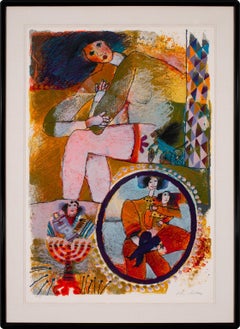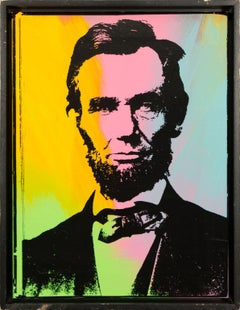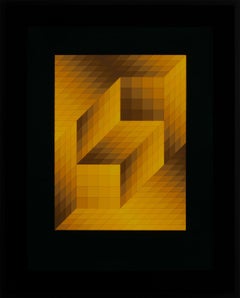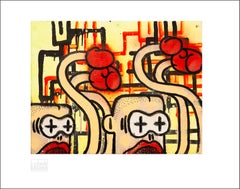la galerie provenance Prints and Multiples
to
4
1
3
Overall Width
to
Overall Height
to
2
1
1
1
1
1
3
1
2
1
3
1
1
1
1
1
2
2
2
1
1
3
4
4
Théo Tobiasse "Cantate 51 de Bach" Signed 1979 Lithograph, Music & Memory Theme
By Théo Tobiasse
Located in Miami, FL
THÉO TOBIASSE – "CANTATE 51 DE BACH POUR LES JOURS DE LUMIÈRE"
⚜ Lithograph on paper ⚜ Hand signed and numbered ⚜ Conservation framed
SYMPHONIC FIGURATION FROM TOBIASSE’S FEMME SERI...
Category
1970s Modern Figurative Prints
Materials
Lithograph
"Too Long Three" by Anja Van Herle, Signed 2015 Triptych of Pop Portraits
By Anja Van Herle
Located in Miami, FL
ANJA VAN HERLE – "TOO LONG THREE" (SET OF THREE)
Hand-Embellished Giclée on Canvas ⚜ Hand Signed, Numbered, and Titled ⚜ Frameless Display
ICONIC TRIO OF CONTEMPORARY POP PORTRAITS
...
Category
2010s Pop Art Abstract Prints
Materials
Canvas, Giclée
$2,730 Sale Price
35% Off
Steve Kaufman "Abraham Lincoln" 1990 Artist Proof Serigraph, Hand Signed Verso
By Steve Kaufman
Located in Miami, FL
STEVE KAUFMAN – "ABRAHAM LINCOLN"
⚜ Serigraph on Canvas ⚜ Initialed Verso ⚜ Edition 48/50 AP ⚜ Black Float Frame
VIBRANT POP ICONOGRAPHY OF AN AMERICAN LEGEND
This bold 1990 serigra...
Category
1990s Pop Art Abstract Prints
Materials
Screen, Canvas
Victor Vasarely "Axo-Charga" Hand-Signed Limited Edition Serigraph, Framed
By Victor Vasarely
Located in Miami, FL
"AXO-CHARGA" BY VICTOR VASARELY (1906-1997)
Serigraph on Black Paper ⚜ Signed ⚜ Numbered ⚜ Framed
A VISIONARY MASTERWORK OF OP ART
"Axo-Charga" is a striking original serigraph by V...
Category
1970s Op Art Abstract Prints
Materials
Screen, Paper
$3,575 Sale Price
35% Off
Related Items
Boxers
Located in Red Bank, NJ
Boxers by KEMOS
Signed on front, lower right
Print, Graffiti, Graffiti Art, Boxers, Abstract, Bright and Vivid Colors, Pattern
Category
21st Century and Contemporary Abstract Figurative Prints
Materials
Archival Paper, Giclée
The Ring
By Manfred Schwartz
Located in Astoria, NY
Manfred Schwartz (American, b. Poland, 1909-1970), The Ring, Abstract Figural Composition, Lithograph on Paper, mid 20th century, two nude figures in dangling hoop, numbered edition ...
Category
Mid-20th Century Modern Figurative Prints
Materials
Paper, Lithograph
Ripples of Colour, Art print, Abstract, Water, Line art, Blue green, red, white
By Chris Keegan
Located in Deddington, GB
This is a Five colour screen print Including a metallic Silver layer. This print is then finished off by drawing over the print with multi-coloured paint including Gold, Yellow and G...
Category
2010s Abstract Abstract Prints
Materials
Paper, Screen
$412
H 21.93 in W 22.05 in D 0.04 in
Agam Lenticular Kinetic Agamograph Hand Signed numbered Israeli Kinetic Op Art
By Yaacov Agam
Located in Surfside, FL
Yaacov Agam, Israeli (b. 1928)
Hand signed, and numbered.
Limited edition lenticular lens kinetic Agamograph
Titled 'Sea Fathom'. Hand-signed and numbered edition 24/99,
size of w...
Category
20th Century Op Art Abstract Prints
Materials
Lenticular, Screen
$3,800
H 17.88 in W 22.38 in
Moment of Silence
By Mr Brainwash
Located in London, GB
6-Colour Screen Print on Archival Paper
hand-signed and numbered by the artist
57.2 cm x 57.2 cm
Edition 108 of 150
Artwork by Mr. Brainwash, (the pseudonym of French-born artist ...
Category
2010s Street Art Abstract Prints
Materials
Archival Paper, Screen
The painter. 1943, paper, lithograph, 56x46 cm
By Marcel Gromaire
Located in Riga, LV
Marcel Gromaire (1892-1971) - The Painter. 1943, paper, lithograph, 56x46 cm
Category
1940s Modern Abstract Prints
Materials
Paper, Lithograph
$713 Sale Price
20% Off
H 22.05 in W 18.12 in D 0.04 in
Life Form Show for Your Distraction
Located in Red Bank, NJ
Life Form Show for Your Distraction by Scott Harbison
Signed on front, lower right
rint, Outsider Art, Weird Figures, Weird Characters, Figures, Bright and Vivid Colors, Pastel, Wh...
Category
21st Century and Contemporary Abstract Abstract Prints
Materials
Archival Paper, Giclée
Violet Torso on Orange Stripes
By Henry Moore
Located in London, GB
Lithograph in four colours on Japon nacré paper
31 x 31 cm - framed
Edition of 75
Hand-signed and numbered by the artist
Henry Moore’s prints are a vital aspect of his artistic lega...
Category
1960s Modern Abstract Prints
Materials
Lithograph
Rubin from Album Lapidaire - Op Art
By Victor Vasarely
Located in London, GB
Victor Vasarely (Hungarian/French, 1906-1997)
Rubin, 1964
Screenprint in Colours
from the Lapidaire portfolio
signed in pencil lower right with blind stamp, numbered edition "41/15...
Category
1960s Op Art Abstract Prints
Materials
Screen
The Boundaries Of Our Realities Are Set By The Limits Of Our Imagination
By The Connor Brothers
Located in New York, NY
A pristine color screenprint, acrylic and oil paint and varnish over giclée on paper. Signed and dated in white ink by the Connor Brothers. Dimensions with the frame are 32 x 22 inches.
Category
2010s Modern Figurative Prints
Materials
Paper, Varnish, Oil, Acrylic, Color, Giclée, Screen
$6,000
H 29.25 in W 19.5 in
Pablo Picasso Estate Hand Signed Fauvist Lithograph Woman Portrait Marie Therese
By Pablo Picasso
Located in Surfside, FL
Pablo Picasso (after)
"Portrait de Marie Therese"
limited edition print on Arches paper,
Hand signed by Marina Picasso lower right and numbered 274/500 lower left
From the estate of Pablo Picasso with an embossed blindstamp in the lower right side of the piece.
After Pablo Picasso's death in 1973, his granddaughter Marina authorized the printing of these original lithographs, which have come to be known as the Picasso Estate Collection. The lithographs were meticulously created after the original works (Oil Paintings, Watercolors, Pastels, Charcoal Drawings, etc.) by Master Chromist Marcel Salinas, who worked closely with Picasso in his lifetime. They are printed in an edition of 500 on Arches paper. Embossed with the estate and chromist's stamp seals, along with the legend on the reverse "Approved by the heirs of Pablo Picasso".
Image: 19 1/2" x 15". Paper: 28" x 20 3/4".
Pablo Ruiz Picasso (1881 – 1973) was a Spanish painter, sculptor, printmaker, ceramicist, stage designer, poet and playwright who spent most of his adult life in France. Regarded as one of the most influential artists of the 20th century, he is known for co-founding the Cubist movement, the invention of constructed sculpture, the co-invention of collage, and for the wide variety of styles that he helped develop and explore. Among his most famous works are the proto-Cubist Les Demoiselles d'Avignon (1907), and Guernica (1937), a dramatic portrayal of the bombing of Guernica by the German and Italian air forces during the Spanish Civil War...
Category
20th Century Modern Abstract Prints
Materials
Lithograph
$3,600
H 28 in W 20.75 in
Victor Vasarely "Zaphir 2" Screenprint in Colors
By Victor Vasarely
Located in Astoria, NY
Victor Vasarely (Hungarian/French, 1906-1997), "Zaphir 2", Screenprint in Colors, unsigned, silver-tone frame. Image: 27" H x 25.5" W; frame: 32.75" H x 29.5" W. Provenance: From a N...
Category
20th Century Op Art More Prints
Materials
Screen





